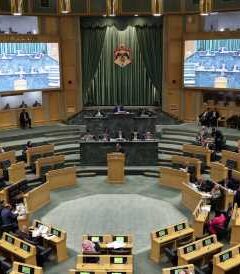Home » Middle East »
Dreams in the Rubble: An Israeli Airstrike and the 22 Lives Lost
GAZA CITY — As Israeli airstrikes hit Gaza City for the sixth night running, Dr. Ayman Abul Ouf climbed the stairs of the apartment block that his family built four decades ago, calmer than he had seemed all day. The Abul Ouf Building, nestled in a wealthy shopping district on Al Wahda Street, was the last place he thought Israel would hit.
He returned to his third-floor apartment at half-past midnight, after a 16-hour day running the coronavirus team at Gaza’s biggest hospital. He could hear the bombs, but mainly from the television in his living room. His upscale neighborhood was considered so safe that in wars past relatives from elsewhere in Gaza waited out the bombing in his apartment.
In the room next door, his son Tawfiq, a high-school senior, was studying for a science exam. One floor below, Dr. Abul Ouf’s father, a scientist also named Tawfiq, was making a late-night meal. One floor above, his cousin’s daughter, Shaimaa, a dentistry student, was texting her fiancé.
Minutes later, they were all dead.
At about 1 a.m. on Sunday, May 16, an Israeli airstrike killed 21 of the 38 people in the building that night. A 22nd resident died of her injuries nearly three weeks later.
The Israeli military said the target of the strike was not the apartment building but a tunnel under the street in front of it.
In a conflict in which both sides are accused of war crimes, the air raid on Al Wahda Street that night stands out for its shocking civilian death toll and for nearly decimating entire families. The attack, which also destroyed another residential building on the street, was the single deadliest episode in the recent 11-day war between Israel and Hamas, killing a total of 44 people.
A fragile cease-fire was tested this week after militants sent incendiary balloons into Israel, and Israel responded with airstrikes.
But the raid on Al Wahda Street remains emblematic of the debate over whether Israel, in striking what it said were legitimate military targets, could have avoided killing civilians. And to what extent Hamas, the militant group that controls Gaza, also bears responsibility for burrowing military infrastructure beneath cities.
What is not disputed is that the thriving, largely upper-middle class community that inhabited the five-story Abul Ouf Building was destroyed in a flash. The block housed the families of a doctor, a scientist, a waiter, a shopkeeper and a psychologist. For the family that owned it — the Abul Oufs — it embodied 40 years of hopes and aspirations.
“There are a lot of memories still there,” said Riad Ishkontana, a 42-year-old waiter who lost his wife and four of their five children. “But the Israeli bombing buried them.”
The conflict began a few days earlier, shortly after 6 p.m. on May 10, when Hamas fired a half-dozen rockets toward Jerusalem. Hamas said it was responding to Israeli actions in East Jerusalem, including police raids on the Aqsa Mosque compound and the planned eviction of Palestinian residents — provocations, it said, that demanded a forceful rebuke.
The Hamas rocket attack, which experts say likely constituted a war crime because it targeted civilian areas, prompted Israel to return fire with airstrikes. Israel soon focused on a network of tunnels Hamas used to transfer weapons and fighters undetected.
In an interview, an Israeli military spokesman, Lt. Col. Jonathan Conricus, said that on the morning of May 16, several Israeli aircraft fired 11 missiles along a 200-yard stretch of Al Wahda Street, aiming to destroy a tunnel and command center beneath it. Drone video filmed soon afterward by the Israeli military showed a row of craters left in the road by GPS-guided bombs.
But while most of the adjacent buildings remained standing, the Abul Ouf Building collapsed in what the official described as “a freak event.”
The military had not known the exact location of the command center, nor how far it extended under nearby buildings, Colonel Conricus said. When the bombs exploded deep underground, they unexpectedly dislodged the Abul Ouf Building’s foundations, he added.
Colonel Conricus said the army, the Israel Defense Forces, “takes every plausible measure to prevent harm to civilian lives and property.”
“Despite the fact that Hamas deliberately constructs its subterranean military infrastructure beneath civilian buildings,” he said, “whenever feasible the I.D.F. strikes this infrastructure by striking open areas, while attempting to prevent damage to near buildings.”
Hamas has acknowledged building a network of tunnels under Gaza for military purposes, but in a news conference on May 26, Yahya Sinwar, leader of the Hamas political wing in Gaza, denied that any of them lay under civilian areas, dismissing the accusation as “baseless.”
However, the United Nations believes Hamas built at least one military tunnel under a U.N. school.
Rights experts said the use of such powerful weapons in a dense urban environment put civilian lives at risk and was a possible war crime. And if Hamas installed military facilities underneath residential areas, that too was a possible war crime.
The building’s owners, the Abul Ouf family, lived in Gaza before the arrival of thousands of Palestinian refugees after the Arab-Israeli war of 1948, granting them an elevated social position. Dr. Abul Ouf, 50, ran the internal medicine department at the Shifa Hospital.
His father, Tawfiq Abul Ouf, 80, was for decades a senior chemist at an Emirati oil company, relatives said. The doctor’s cousin, Raja, who lived with her four children in a third-floor apartment, was a psychologist.
“It’s a well-known address,” said Muhammad el-Shanty, 29, who runs a bakery opposite. “When you call a taxi, you might say, ‘Pick me up by the Abul Ouf Building.’”
Like many Gaza residents, a majority of the building’s residents had never left the strip. An Israeli and Egyptian blockade, imposed after Hamas seized control of the territory in 2007, has largely confined Gaza’s residents to one of the world’s most densely populated slivers of land. It has also contributed to severe fuel and electricity shortages: Even the Abul Ouf Building received power for just eight hours a day.
Still, its residents had dreams. The doctor’s son, Tawfiq, hoped to study chemistry at college, his brother said. His second cousin, Shaimaa, was just two months from her wedding.
The Abul Oufs moved to the area in 1960, the family said. Ismail Abul Ouf, the family patriarch, had made a fortune manufacturing pastries and trading real estate. He bought a villa with a large yard in Rimal, then a mostly undeveloped area on the edge of Gaza City.
In the early 1980s, as his family grew, he knocked down the villa and built the block now known as the Abul Ouf Building. By the time of the airstrike, it housed eight apartments, including five that the Abul Oufs used.
After the Oslo Accords, the interim peace agreements between Israel and the exiled Palestinian leadership, were signed in the 1990s, senior Palestinian leaders returned to Gaza, bringing a rush of investment. Tall buildings popped up across Rimal. Suddenly, it became a bustling shopping district.
That excitement turned to gloom in the 2000s, after Hamas, which does not recognize Israel’s right to exist, won elections then seized power in Gaza. That split the enclave from the occupied West Bank and led to several wars with Israel.
Through them all, the Abul Ouf compound remained a sanctuary, hosting relatives from more dangerous parts of Gaza.
“We have gone through many wars,” said Omar Abul Ouf, the doctor’s 16-year-old son, “but our place is always safe.”
After staying late at the hospital, Dr. Abul Ouf was dropped near his apartment that night by an ambulance driver. The doctor seemed cheerful, happy to be heading home, the driver said.
Half an hour later, the doctor was stretched out before the television on a mattress he had dragged from a bedroom, Omar remembered. When the air raid began, Omar instinctively jumped to his feet, grabbed his little sister, Tala, 12, and pulled her into the corridor.
His father was still lying on the mattress. Then the building collapsed.
Shaimaa Abul Ouf’s fiancé, Anas al-Yazji, lived nearby and heard the explosions.
“Hide,” he texted Shaimaa.
The message never reached her phone.
Tala died in Omar’s arms, as they embraced underneath the rubble.
Rescuers found them on Sunday afternoon, 12 hours later. Of the five family members living in Dr. Abul Ouf’s apartment, only Omar survived.
Mr. Ishkontana, who lived on the fourth floor, is a descendant of refugees who fled to Gaza in 1948. This was the second time his family had lost their home in three generations, he said.
Abeer Abdel Aal, 38, Dr. Abul Ouf’s cousin, lives in an apartment so close to her relatives’ destroyed building that she used to pass food to them across a narrow alleyway.
But Dr. Abul Ouf is now dead. The Abul Ouf Building is gone. And with it, four decades of a family’s history.
“It feels like a tree that has been cut down,” she said.
Soliman Hijjy contributed reporting.
Source: Read Full Article



